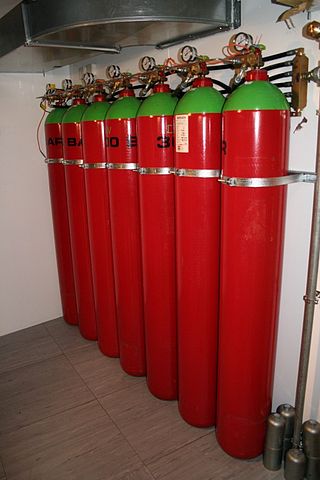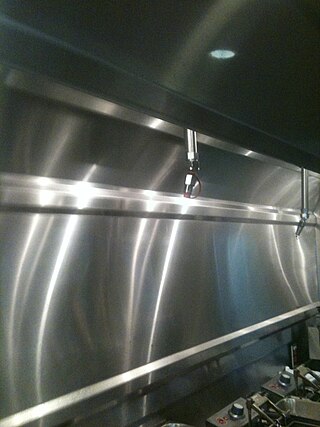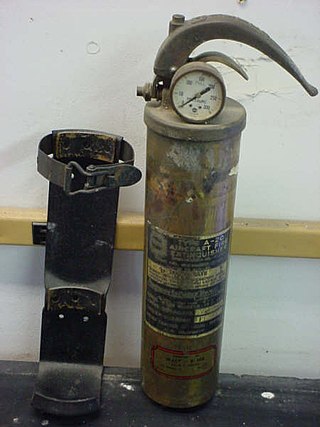
A fire sprinkler system is an active fire protection method, consisting of a water supply system providing adequate pressure and flowrate to a water distribution piping system, to which fire sprinklers are connected. Although initially used only in factories and large commercial buildings, systems for homes and small buildings are now available at a cost-effective price.

Bromochlorodifluoromethane (BCF), also referred to by the code numbers Halon 1211 and Freon 12B1, is a haloalkane with the chemical formula CF2ClBr. It is used for fire suppression, especially for expensive equipment or items that could be damaged by the residue from other types of extinguishers. It is stored as a liquid under pressure and vaporizes when discharged to suppress fires. The use of halons, including Halon 1211, has decreased over time due to their adverse impact on the ozone layer. Alternatives have been developed to mitigate environmental concerns while still providing effective fire suppression capabilities.
Bromotrifluoromethane, commonly referred to by the code numbers Halon 1301, R13B1, Halon 13B1 or BTM, is an organic halide with the chemical formula CBrF3. It is used for gaseous fire suppression as a far less toxic alternative to bromochloromethane.

Halomethane compounds are derivatives of methane with one or more of the hydrogen atoms replaced with halogen atoms. Halomethanes are both naturally occurring, especially in marine environments, and human-made, most notably as refrigerants, solvents, propellants, and fumigants. Many, including the chlorofluorocarbons, have attracted wide attention because they become active when exposed to ultraviolet light found at high altitudes and destroy the Earth's protective ozone layer.

Gaseous fire suppression, also called clean agent fire suppression, is the use of inert gases and chemical agents to extinguish a fire. These agents are governed by the National Fire Protection Association (NFPA) Standard for Clean Agent Fire Extinguishing Systems – NFPA 2001 in the US, with different standards and regulations elsewhere. The system typically consists of the agent, agent storage containers, agent release valves, fire detectors, fire detection system, agent delivery piping, and agent dispersion nozzles.

1,1,1,2,3,3,3-Heptafluoropropane, also called heptafluoropropane, HFC-227ea, HFC-227 or FM-200, as well as apaflurane (INN), is a colourless, odourless gaseous halocarbon commonly used as a gaseous fire suppression agent.
Trifluoroiodomethane, also referred to as trifluoromethyl iodide is a halomethane with the formula CF3I. It is an experimental alternative to Halon 1301 (CBrF3) in unoccupied areas. It would be used as a gaseous fire suppression flooding agent for in-flight aircraft and electronic equipment fires.
Fire protection is the study and practice of mitigating the unwanted effects of potentially destructive fires. It involves the study of the behaviour, compartmentalisation, suppression and investigation of fire and its related emergencies, as well as the research and development, production, testing and application of mitigating systems. In structures, be they land-based, offshore or even ships, the owners and operators are responsible to maintain their facilities in accordance with a design-basis that is rooted in laws, including the local building code and fire code, which are enforced by the authority having jurisdiction.

Fire suppression systems are used to extinguish, control, or in some cases, entirely prevent fires from spreading or occurring. Fire suppression systems have an incredibly large variety of applications, and as such, there are many different types of suppression systems for different applications being used today. Of these, there are some that are still in use but are no longer legal to manufacture and produce.
Active fire protection (AFP) is an integral part of fire protection. AFP is characterized by items and/or systems, which require a certain amount of motion and response in order to work, contrary to passive fire protection.
A fire class is a system of categorizing fire with regard to the type of material and fuel for combustion. Class letters are often assigned to the different types of fire, but these differ between territories; there are separate standards for the United States, Europe, and Australia. The fire class is used to determine the types of extinguishing agents that can be used for that category.

Bromochloromethane or methylene bromochloride and Halon 1011 is a mixed halomethane. It is a heavy low-viscosity liquid with refractive index 1.4808.
The Centre for Fire, Explosive and Environment Safety (CFEES) is an Indian defence laboratory of the Defence Research and Development Organisation (DRDO). Located in Timarpur, Delhi, its main function is the development of technologies and products in the area of explosive, fire and environmental safety. CFEES is organised under the Armaments Directorate of DRDO. The present director of CFEES is Arvind Kumar
PhostrEx is a fire suppression agent developed for use in aviation applications to replace halon, a greenhouse gas (GHG). It was developed by Eclipse Aviation for use aboard their Eclipse 500 very light jets as an engine fire suppression system, and is now being marketed to other aviation manufacturers.

A fire extinguisher is a handheld active fire protection device usually filled with a dry or wet chemical used to extinguish or control small fires, often in emergencies. It is not intended for use on an out-of-control fire, such as one which has reached the ceiling, endangers the user, or otherwise requires the equipment, personnel, resources or expertise of a fire brigade. Typically, a fire extinguisher consists of a hand-held cylindrical pressure vessel containing an agent that can be discharged to extinguish a fire. Fire extinguishers manufactured with non-cylindrical pressure vessels also exist but are less common.

Pentafluoroethane is a fluorocarbon with the formula CF3CHF2. Pentafluoroethane is currently used as a refrigerant (known as R-125) and also used as a fire suppression agent in fire suppression systems.

Condensed aerosol fire suppression is a particle-based method of fire extinction. It is similar to but not identical to dry chemical fire extinction methods, using an innovative pyrogenic, condensed aerosol fire suppressant. It is a highly effective fire suppression method for class A, B, C, E and F. Some aerosol-generating compounds produce a corrosive by-product that may damage electronic equipment, although later generations lower the effect.

Clean agent FS 49 C2 is an environmentally engineered, human safe, fast acting Clean Agent fire extinguishing gas for gaseous fire suppression installed in a suited fire suppression system. The gas consists of tetrafluoroethane, pentafluoroethane and carbon dioxide.
Graviner is a British engineering company that makes oxygen and fire extinguishing systems for civil and military aircraft. The name is a portmanteau of gravity and inertia.
A spark extinguishing system is used for preventive fire protection. A spark extinguishing system can detect and eliminate ignition sources before a fire or dust explosion occurs. Systems for grinding, chopping, drying, cooling and pressing materials including their pneumatic or mechanical transport and extraction systems and facilities for separation or storage purposes, also dust collectors, filters, cyclones, silos, and hoppers are especially at risk.












